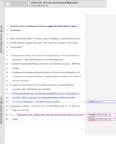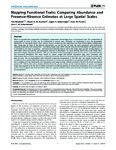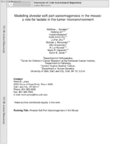1 - 25 of 5
| Creator | Title | Description | Subject | Date | ||
|---|---|---|---|---|---|---|
| 1 |
 |
Yamaguchi, Ayako | Development of an acute method to deliver transgenes into the brains of adult Xenopus laevis | The central vocal pathway of the African clawed frog, Xenopus laevis, is a powerful vertebrate model to understand mechanisms underlying central pattern generation. However, fast and efficient methods of introducing exogenous genes into the neurons of adult X. laevis are currently not available. Her... | viral vector; vesicular stomatitis virus; Xenopus laevis; transgene; neurons; vocalizations; central pattern generator; electroporation | 2018 |
| 2 |
 |
Sekercioglu, Cagan | Keystone species in seed dispersal networks are mainly determined by dietary specialization | One central issue in Ecology ecology has been the definition and identification of keystone species, i.e., species that are relatively more important than others for maintaining the structure of a community. Several keystone species concepts have been proposed, and network theory has been pointed o... | 2014-01-01 | |
| 3 |
 |
Sekercioglu, Cagan | Mapping functional traits: comparing bundance and presence-absence estimates at large spatial scales | Efforts to quantify the composition of biological communities increasingly focus on functional traits. The composition of communities in terms of traits can be summarized in several ways. Ecologists are beginning to map the geographic distribution of trait-based metrics from various sources of data,... | 2012-01-01 | |
| 4 |
 |
Capecchi, Mario R. | Modeling alveolar soft part sarcomagenesis in the mouse: a role for lactate in the tumor microenvironment | Alveolar soft part sarcoma (ASPS), a deadly soft tissue malignancy with a predilection for adolescents and young adults, associates consistently with t(X;17) translocations that generate the fusion gene ASPSCR1-TFE3. We proved the oncogenic capacity of this fusion gene by driving sarcomagenesis in m... | 2014-01-01 | |
| 5 |
 |
Lawton, Kristy J. | Motor neurons tune premotor activity in a vertebrate central pattern generator | Central patterns generators (CPGs) are neural circuits that drive rhythmic motor output without sensory feedback. Vertebrate CPGs are generally believed to operate in a top-down manner in which premotor interneurons activate motor neurons that in turn drive muscles. In contrast, the frog (Xenopus la... | CPG; feed back; synchrony; vocal; vocalization; Xenopus | 2017 |
1 - 25 of 5
